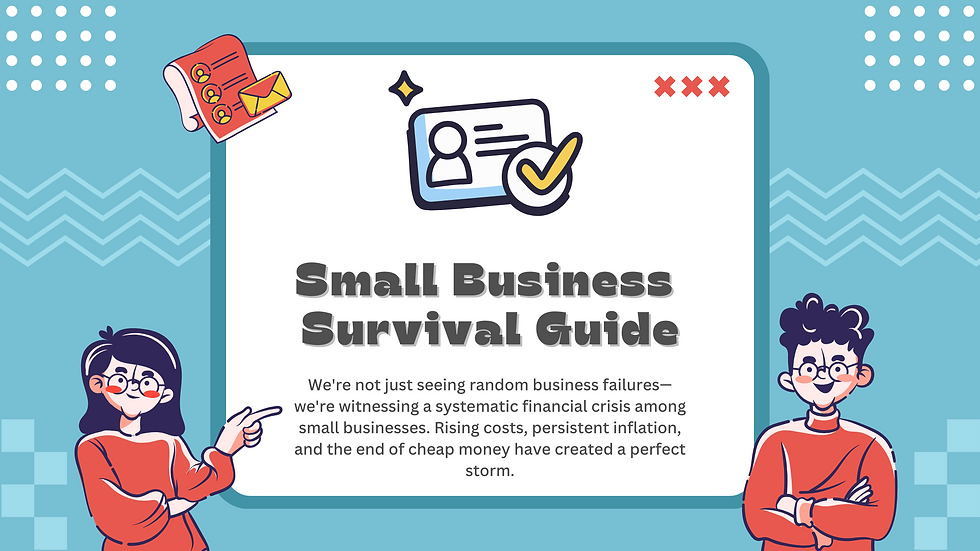The Small Business Bankruptcy Crisis Nobody's Talking About (But You Need to Know)
- Cynthia Nevels

- Jul 27
- 3 min read
Updated: Nov 26
Post July 27, 2025 #business #bankruptcy #survival #economy
2025 is shaping up to be a challenging year for small businesses—and yours could be next in line if you're not careful.

The numbers are staggering. Business bankruptcy filings have surged 14.7% nationwide in 2025, with some regions like Dallas-Fort Worth seeing a jaw-dropping 140% increase over 2023. We're talking about 23,309 businesses that filed for bankruptcy in just the first quarter of 2025 alone.
But here's what's really keeping me up at night: most business owners have no idea they're working with financially distressed companies until it's too late.
The Post-Pandemic Reckoning Has Arrived
Remember all that stimulus money that kept businesses afloat during COVID? Well, the party's over. As one bankruptcy attorney put it, we're seeing the "dry-out" from trillions in federal stimulus, and businesses that never truly recovered are finally hitting the wall.
The industries getting hit hardest? Healthcare, hospitality, and retail are leading the charge. But no sector is immune—from tech startups to manufacturing, the financial stress is spreading like wildfire.
What Business Owners Need to Know About Bankruptcy Types
Not all bankruptcies are created equal, and understanding the difference could save your business:
Chapter 7 (Liquidation): Game over. The business shuts down permanently, assets get sold off, and employees get laid off. If you're a sole proprietor, your personal assets are on the line too.
Chapter 11 (Reorganization): The business continues operating while restructuring debt under court supervision. Sounds better, right? Here's the kicker: most Chapter 11 filings fail and get converted to Chapter 7 anyway.
Your Business Structure Matters: If you're an LLC or corporation, your personal assets might be protected. But if you're a sole proprietor or signed personal guarantees (and let's be honest, most of us have), you're personally liable for business debts even after bankruptcy.
The Hidden Danger to Your Business
Here's what scares me most: 50% of households entering bankruptcy are already facing legal action—foreclosures, repossessions, wage garnishments. These aren't sudden failures; they're slow-motion train wrecks.
And if you're doing business with one of these companies? You could be left holding the bag for unpaid invoices, undelivered goods, or incomplete services.

Protect Your Business: Due Diligence That Actually Works
Stop doing business on handshakes and hope. Here's your financial health checklist:
Before Signing Any Contract:
Run a credit check on the business AND its owners
Search bankruptcy records (they're public—use PACER or hire a service)
Request recent financial statements
Check for liens or judgments
Verify they can actually pay what they owe
Red Flags That Should Stop You Cold:
Delays in payment without explanation
Requests to change payment terms suddenly
High employee turnover
Closed locations or reduced hours
Avoiding financial disclosure
Smart Business Practices:
Require upfront payments or deposits for large orders
Set clear payment terms (net 15, not net 30)
Consider trade credit insurance for big contracts
Monitor your customers' financial health regularly
The Harsh Reality
We're not just seeing random business failures—we're witnessing a systematic financial crisis among small businesses. Rising costs, persistent inflation, and the end of cheap money have created a perfect storm.
The businesses that survive 2025 won't just be the ones with the best products or services. They'll be the ones smart enough to protect themselves from financial contagion.
Your Action Plan
Audit your current customers: Who owes you money? Can they actually pay?
Tighten your credit policies: Better to lose a risky customer than lose your business
Diversify your client base: Don't let one customer represent more than 20% of your revenue
Build cash reserves: Three months of operating expenses minimum
Know your own numbers: You can't protect what you can't measure
The Bottom Line
The small business bankruptcy wave isn't coming—it's already here. While you can't control the economy, you can control who you do business with and how you protect your company.
Your business didn't survive the pandemic and inflation just to be taken down by someone else's poor financial decisions.
Do your homework. Protect your cash flow. Trust but verify.
Because in 2025, your due diligence isn't just good business practice—it's survival.
What financial red flags have you noticed in your industry? Share your experiences in the comments—your insight could save someone's business.
Found this helpful? Share it with other business owners who need to see this or schedule an appointment with us at Integrality, LLC for an analysis of your business. www.integralityllc.com




No matter the need, finding the right Call Girl in Rishikesh ensures that the experience feels genuine and meaningful. Their professionalism, elegance, and commitment to discretion make them stand apart.